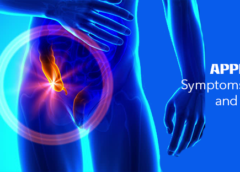Overview
Appendicitis is a swelling of the appendix, a finger-shaped pouch which projects on the lower right side of your abdomen from your colon.
Appendicitis in your lower right abdomen causes discomfort. However, pain starts around the navel in most cases and then moves. Appendicitis pain usually increases as inflammation worsens, and ultimately becomes severe.
While anyone may develop appendicitis, it mostly occurs commonly in people between the ages of 10 and 30. Normal treatment is removing the appendix by surgery.
Signs and symptoms of Appendicitis
Signs and symptoms of appendicitis may include:
- Sudden pain which starts begins on the right side of the lower abdomen
- Sudden pain which starts around your navel and mostly shifts to your lower right abdomen
- Pain which occurs when you cough, walk or make other jarring movements
- Nausea and vomiting
- Appetite loss
- Low-grade fever which may worsen as the illness progresses
- Constipation or diarrhoea
- Abdominal bloating
- Flatulence
Depending on your age and the position of your appendix, the site of your pain can differ. The pain can appear to come from your upper abdomen when you are pregnant since your appendix is higher during pregnancy.
When to see a doctor
When you or your child has worrisome signs or symptoms, make an appointment with a doctor. Severe abdominal pain demands urgent medical attention
Causes
The probable cause of appendicitis is a blockage in the lining of the appendix which results in infection. The bacteria are quickly growing, causing the appendix to get inflamed, and filled with pus. If the appendix is not treated promptly, it may rupture.
Risk factors
Appendicitis may impact anyone. Yet some people can develop this condition more often than others. Risk factors for appendicitis can include:
- Age: Appendicitis most often affects people between the 15 of age and 30 of age.
- Sex: Appendicitis is more often in males than in females.
- Family history: People with a family history of appendicitis have a greater risk of developing appendicitis.
Although more research is needed, low-fibre diets could also increase the risk of appendicitis.
Complications
Appendicitis may cause severe complications, like:
- A Ruptured Appendix: A rupture spreads infection (peritonitis) throughout the abdomen. This condition may be life-threatening and requires immediate surgery to remove the appendix and clean the cavity of the abdomen.
- Pocket of pus which forms in the abdomen: If your appendix bursts, an abscess may develop. For most cases, a surgeon drains the abscess by inserting a tube into the abscess through the abdominal wall. The tube is left in place for about 2 weeks, and antibiotics are given to clear the infection.
When the infection is clear, the appendix can be removed by surgery. The abscess is drained in some cases and the appendix is then removed.
Types
Appendicitis may be acute or chronic. In acute cases of appendicitis, the symptoms tend to be severe and develop suddenly. The symptoms can be milder in chronic conditions and can come and go on for several weeks, months or even years.
The condition may be simple or complex too. There are no complications in simple cases of appendicitis. Severe cases include complications such as a ruptured appendix or an abscess.
Diagnosis
Your doctor will typically take a summary of your signs and symptoms, and examine your abdomen to help diagnose appendicitis.
Tests and techniques for diagnosing appendicitis include:
Physical examination to determine your pain: Your doctor can apply gentle pressure on the painful area. When the pressure is suddenly released, appendicitis pain will often feel worse, signalling that the adjacent peritoneum is inflamed Physical examination to determine the discomfort. Your doctor can apply gentle pressure on the painful area. When the pressure is abruptly released, appendicitis pain will mostly always feel worse, which indicates that the peritoneum is inflamed.
Your doctor may look for abdominal stiffness and a tendency for you to stiffen your abdominal muscles in response to pressure over the inflamed appendix (guard).
A lubricated, gloved finger can be used by your doctor to test your lower rectum (digital rectal exam). A pelvic exam may be offered to women of childbearing age to test for any gynaecological conditions that could cause the pain.
Blood test: This allows your doctor to test for a high white blood cell count, which may indicate an infection.
Urine test: Your doctor can want you to have a urinalysis to make sure your pain is not caused by an infection of the urinary tract or a kidney stone.
Imaging tests: Your doctor may also prescribe you an abdominal X-ray, an abdominal ultrasound, computerized tomography (CT) scan or magnetic resonance imaging (MRI) to help validate appendicitis or other pain causes.
Preventions
There is no way to guard against appendicitis. However, it may be less likely in people who consume high-fibre foods like fresh fruits and vegetables.

Leave a Reply
You must be logged in to post a comment.